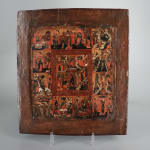The Resurrection and Harrowing of Hell with Feasts, 18th to 19th century AD
Paint on Wood
30.6 x 27.2 x 2.2 cm
12 1/8 x 10 3/4 x 7/8 in
12 1/8 x 10 3/4 x 7/8 in
GM.0106
Further images
This beautiful panel presents the scenes of the Resurrection and the harrowing of hell along with scenes from the the history of salvation and the great festivals of the Christian...
This beautiful panel presents the scenes of the Resurrection and the harrowing of hell along with scenes from the the history of salvation and the great festivals of the Christian year. The wooden panel has been painted with minute details alongside with the application of gold leaves (in Byzantine iconography gold is used to symbolise light rather then being a colour).
Starting from the first on the top left and moving clockwise, there is the Nativity of the Virgin; The Presentation of the Virgin at the Temple; The Annunciation; The Nativity of Christ; The Baptism of Christ; The Transfiguration of Christ; The Elevation of the Cross; The Dormition of the Virgin; The Hospitality of Abraham; The Ascension of Christ; The Entry into Jerusalem; The Presentation of Christ to the Temple. The central scene bears the typical double Russian representation of the Resurrection and of the harrowing of hell.
The presence of a double representation of the events related to the Resurrection (and in particular the representation of the scene of the Saviour emerging victorious from the tomb) is typical of Russian iconography. Traditional Byzantine iconography uses for the Paschal events only the scene of the harrowing of hell, here represented in the lower part of the central scene. This iconography depicts Jesus Christ descending into hell to save the characters of the Old Testament starting from Adam and Eve, often symbolically represented being raised from their tombs by Christ. This moving iconography is quintessential of Byzantine Art, and was also made famous by the stunning mosaic with this subject in the Church of Saint Saviour in Chora at Constantinople.
Starting from the first on the top left and moving clockwise, there is the Nativity of the Virgin; The Presentation of the Virgin at the Temple; The Annunciation; The Nativity of Christ; The Baptism of Christ; The Transfiguration of Christ; The Elevation of the Cross; The Dormition of the Virgin; The Hospitality of Abraham; The Ascension of Christ; The Entry into Jerusalem; The Presentation of Christ to the Temple. The central scene bears the typical double Russian representation of the Resurrection and of the harrowing of hell.
The presence of a double representation of the events related to the Resurrection (and in particular the representation of the scene of the Saviour emerging victorious from the tomb) is typical of Russian iconography. Traditional Byzantine iconography uses for the Paschal events only the scene of the harrowing of hell, here represented in the lower part of the central scene. This iconography depicts Jesus Christ descending into hell to save the characters of the Old Testament starting from Adam and Eve, often symbolically represented being raised from their tombs by Christ. This moving iconography is quintessential of Byzantine Art, and was also made famous by the stunning mosaic with this subject in the Church of Saint Saviour in Chora at Constantinople.













